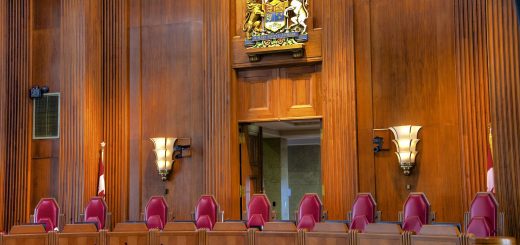APPEAL WATCH: SCC to Rule on Admissibility of Accuseds’ Criminal Records

The Supreme Court of Canada (“SCC”) will soon give direction to lower courts on how to assess the prejudicial and probative value of permitting an accused’s criminal record to be admitted as evidence. In R v Hussein, 2023 ONCA 253 [Hussein], the Court of Appeal for Ontario (“ONCA”) upheld the trial judge’s dismissal of the accused’s Corbett application. These applications allow an accused to challenge the admissibility of their prior criminal record as evidence — which is presumptively admissible under s 12(1) of the Canada Evidence Act, RSC 1985, c C-5 — if the prejudicial effect of the evidence outweighs the probative value of its admission (R v Corbett, [1988] 1 SCR 670 [Corbett]). The SCC has granted leave for appeal to Hussein [41015].
The Case
Factual Background
On February 1, 2017, nine friends got together for a night of heavy drinking in an Ottawa basement apartment (Hussein, para 4). At about 5:00 A.M. on February 2, the victim, Brian Boucher, was stabbed ten times; ultimately, his carotid artery was cut in two, leading to his death (Hussein, para 6).
Mr. Hussein left the scene soon after the stabbing occurred (Hussein, para 14). He fled to a nearby friend’s house, where he met with Ryan Martineau (Hussein, para 15). He told Mr. Martineau that someone had been murdered at the party, and Mr. Martineau noticed a toonie-sized spot of blood on his pants (Hussein, para 15). Mr. Hussein took a cab home, but he returned to Mr. Martineau’s home later that day by cab under a fake name (Hussein, para 16). He stayed at Mr. Martineau’s home for the next few days; he did not have a cellphone during his time there, and he shaved his head after learning he was wanted for Mr. Boucher’s murder (Hussein, para 16).
Mr. Hussein’s blood was found throughout the basement apartment where the stabbing occurred, including near a puncture in the wall that seemed to have been made by a knife (Hussein, para 13). The murder weapon was not found.
Other evidence regarding the stabbing was contradictory. Two attendants at the party, Austin McEwan and Papy Ndiya, claimed that they were first to find Mr. Boucher bleeding, but they both suggested that they were alone when they found him (Hussein, para 7). Mr. Ndiya claimed that he saw a man run past him on the stairs as he descended into the basement apartment to find Mr. Boucher bleeding (Hussein, para 9). The party host’s mother, who lived upstairs, indicated that she saw Mr. Hussein run up the stairs as she descended and that she did not see Mr. Ndiya in the basement (Hussein, para 10).
The police quickly suspected Mr. Hussein. They questioned the other party attendants but did not search them (Hussein, para 13). They also permitted Mr. Ndiya to wash his hands, which were covered in blood (Hussein, para 13).
Superior Court of Justice
At trial, the Crown brought a similar fact evidence application, hoping to show Mr. Hussein’s propensity to reach for knives during conflicts by examining him on instances in his past where he had done so (Hussein, paras 17–18). The trial judge did not permit this evidence to be admitted (Hussein, para 18).
Mr. Hussein then brought a Corbett application to prevent the Crown from cross-examining him on his extensive criminal record: four youth convictions and twelve adult convictions (Hussein, para 19–20). He argued that, at a minimum, the three assault convictions and the uttering threats conviction would cause the jury to make prejudicial inferences of his guilt (Hussein, para 20).
The trial judge dismissed the Corbett application on several grounds.
First, the trial judge found that Mr. Hussein’s criminal record had a high probative value. For one, it showed his disregard/disdain for the law, which was helpful in assessing the credibility of his testimony (Hussein, para 38). Additionally, he found that permitting cross-examination of Mr. Hussein’s criminal record was necessary to prevent a distorted picture from being presented to the jury, as Mr. Hussein’s counsel had already cross-examined Mr. Ndiya on his criminal record (Hussein, para 41).
The trial judge compared the high probative value of the evidence to the low prejudicial effect it would have on the jury. First, he found that the weight of evidence against Mr. Hussein minimised the effect of any prejudicial impact (Hussein, para 39). Further, he held that the key issue in the case was not whether Mr. Hussein stabbed Mr. Boucher, but whether Mr. Hussein could have foreseen death due to his intoxication (Hussein, para 39). He reasoned that the criminal record would have little impact on the jury’s determination of foreseeability (Hussein, para 39).
In the end, the trial judge permitted the Crown to cross-examine Mr. Hussein on his entire criminal record, including the youth convictions (Hussein, para 43). In his jury instructions, the trial judge explained that Mr. Hussein’s criminal record could only be used to assess his credibility on the stand; it could not be used to make inferences regarding his guilt (Hussein, para 44).
The jury found Mr. Hussein guilty of second-degree murder. Prior to sentencing, the trial judge sought recommendations from the jury regarding the appropriate parole eligibility period (Hussein, para 22). Four jurors recommended ten years; however, the trial judge imposed a thirteen-year parole ineligibility period (Hussein, para 22).
Court of Appeal for Ontario
At the ONCA, Mr. Hussein argued that the trial judge erred (1) in dismissing the Corbett application; (2) by failing to instruct the jury on the inadequacies of the police investigation; and (3) in imposing a thirteen-year parole ineligibility period.
The ONCA dismissed the first ground of appeal. Mr. Hussein argued that the trial judge made four errors in dismissing the Corbett application. First, he argued that the trial judge erred in considering the strength of the Crown’s case as a factor that diminished the prejudicial effect of the criminal record. The ONCA found that since Mr. Hussein’s counsel had raised the issue at the application hearing (i.e., by arguing the Crown’s case was weak and thus left a lot of room for prejudice to fill the gaps), the trial judge was justified in responding to that submission (Hussein, para 48). They also held that the strength of the Crown’s case is a relevant factor to consider in a Corbett application (Hussein, para 49).
Second, Mr. Hussein argued that the trial judge erred in finding that the criminal record would not influence the jury’s determination of intent. As summarised by the ONCA, Mr. Hussein argued the following:
a conclusion that an accused person has a tendency to act violently makes it easier to believe that the accused is the kind of person who would intentionally harm another in a fashion that creates a foreseeable risk of death and may have done so in this case (Hussein, para 52).
The ONCA partially agreed with this argument. They found that, although there is a risk that the jury will engage in a general inference that posits Mr. Hussein as more likely to proceed in the face of foreseeable violence, there is little risk that the jury will engage in a specific inference that Mr. Hussein did in fact foresee the risk of death (Hussein, para 55). The ONCA held that even though the trial judge failed to recognize the risk of this general inference, this failure was not overriding (Hussein, para 56).
Third, Mr. Hussein argued that the trial judge’s balancing of the prejudicial effect and probative value of the evidence was unreasonable. The ONCA held that — while there was a compelling case for granting the Corbett application — the trial judge’s decision was not unreasonable (Hussein, para 58). As for prejudicial effect, the ONCA rejected Mr. Hussein’s argument that the trial judge (1) overemphasised the foreseeability issue, failing to adequately consider the fact that Mr. Hussein may not have been the killer at all; (2) contradicted himself when he used Mr. Hussein’s criminal record as evidence of violent disposition during the sentencing hearing; and (3) failed to give adequate consideration to the combined impact of Mr. Hussein’s criminal record and developmental disability on the jury’s determination of his character and credibility (Hussein, paras 59–64). On probative value, the ONCA rejected Mr. Hussein’s argument that the trial judge (1) failed to consider the diminished value of the youth convictions; and (2) overestimated the impact of Mr. Hussein’s cross-examination of Mr. Ndiya (Hussein, paras 66–68).
Fourth, Mr. Hussein argued that the trial judge erred in permitting his entire criminal record to be put to the jury. The ONCA rejected this argument, finding that the trial judge, who recognized that some parts of the record were less probative than others, saw value in presenting the record as a cohesive whole to the jury (Hussein, para 70).
The ONCA also dismissed the second ground of appeal: that the trial judge erred in failing to instruct the jury on the inadequacy of the police investigation. They noted that trial judges are not required to address every argument in their jury instruction (Hussein, para 73). They also found that Mr. Hussein’s counsel were given adequate opportunity to bring this concern to the trial judge before the jury instructions were given (Hussein, paras 73–75).
Finally, the ONCA dismissed Mr. Hussein’s third ground of appeal: that the trial judge erred by failing to follow the parole eligibility recommendations made by the jurors. While they took issue with the trial judge’s comment that he would take the jury recommendations with a “grain of salt,” they concluded that the trial judge still gave the recommendations appropriate consideration (Hussein, paras 79–81). Additionally, the ONCA found no error in the trial judge’s use of a perceived lack of motive as evidence of Mr. Hussein’s dangerousness; importantly, the nuance of the trial judge’s finding (i.e., focusing on his criminal record and the contrast between Mr. Hussein’s quiet demeanour throughout the night and his sudden violent eruption) saved it from being an erroneous conclusion (Hussein, paras 85–87).
Sorting Through the Clutter
It is tough to say where the SCC might go with this appeal. Simply put, there is a lot at issue here. While it is tempting to make the claim that Mr. Hussein took a ‘shotgun approach’ on appeal (i.e., to raise as many issues as possible, hoping that one will succeed), there are valid concerns behind each of the issues raised. Notably, the ONCA recognized the validity of many of the issues raised; while the context and nuance of the trial judge’s considerations provided adequate justification for the ONCA, they were not shy in expressing concern over some of the comments and conclusions made by the trial judge. The SCC, by granting leave for appeal, clearly has some concerns of their own.
I suspect that the SCC will focus most of their attention on the dismissal of the Corbett application. The SCC has not given extensive direction on Corbett applications since their 1988 ruling (with the exception of R v Underwood, [1998] 1 SCR 77, where the SCC held that a Corbett application should be decided by the judge after the Crown closes their case and prior to the opening of the defence’s case). This lack of direction is evidenced by the near absence of references to SCC rulings in the Hussein decision. In line with the preference for admitting evidence of an accused’s criminal record (as indicated by Dickson J in Corbett), I predict that the trial judge’s dismissal of the Corbett application will be upheld. However, the amount of issues raised on appeal in this case will allow the SCC to give more detailed direction to lower courts seeking to exercise their discretion in a Corbett application.







Join the conversation